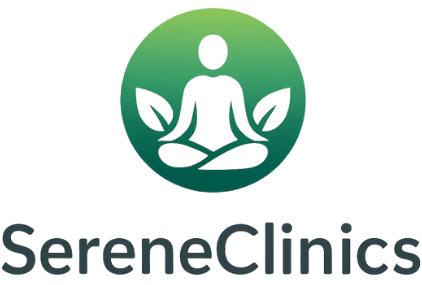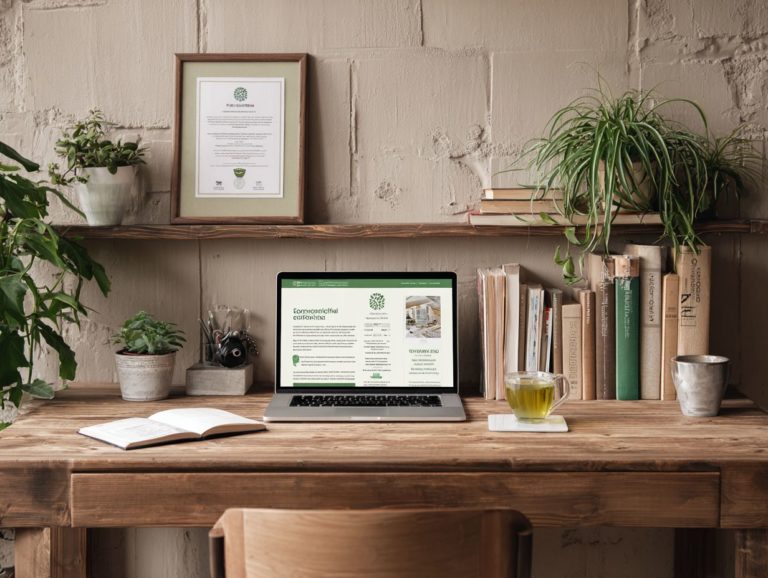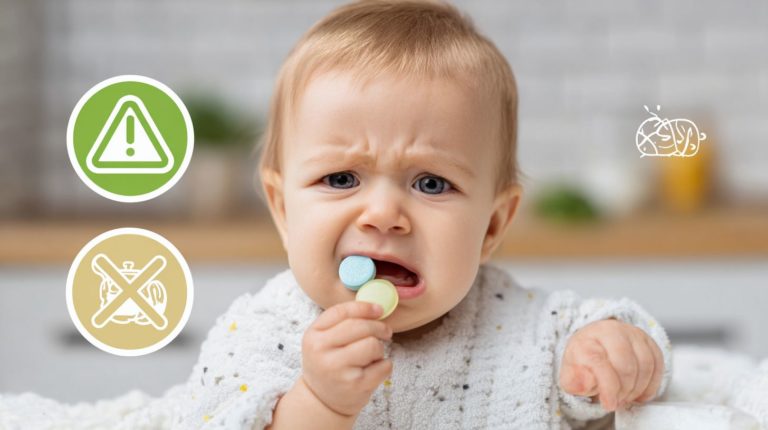Homeopathic Products: Safety, Risks, and Usage for Children
Many Canadians are increasingly choosing homeopathic products as different health options for their children. As more people become interested in natural health choices, knowing the safety and possible dangers of homeopathy is important. Health Canada provides guidelines for using these remedies, but parents must remain informed. This article looks at how to use homeopathic products safely, the possible risks, and gives practical advice to help parents make informed decisions about their children’s health care.
Key Takeaways:
Contents
- 1 Understanding Homeopathic Products
- 2 Safety of Homeopathic Products for Children
- 3 Children’s Homeopathy Safety Data
- 4 Potential Risks of Homeopathic Products
- 5 Usage Guidelines for Homeopathic Products in Children
- 6 Common Homeopathic Remedies for Children
- 7 Parental Considerations and Responsibilities
- 8 Frequently Asked Questions
- 8.1 What are homeopathic products and are they safe for children?
- 8.2 Are there any risks associated with using homeopathic products for children?
- 8.3 How do I know which homeopathic products are safe for my child?
- 8.4 Can homeopathic products be used to treat specific health conditions in children?
- 8.5 Is there a recommended dosage for homeopathic products in children?
- 8.6 Are there any side effects of using homeopathic products in children?
Definition of Homeopathy
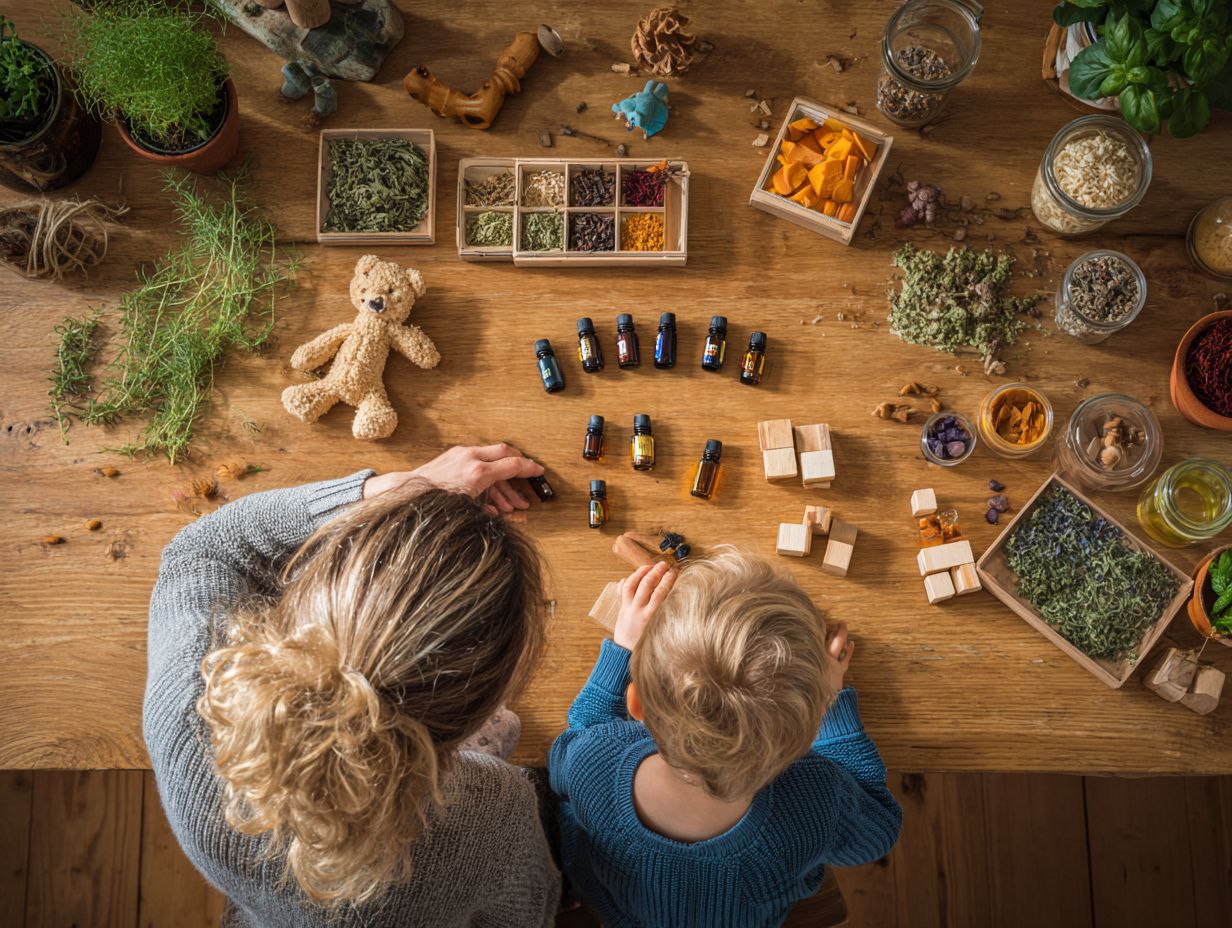
Homeopathy is defined as a system of medicine developed by Samuel Hahnemann that uses the principle of ‘like cures like,’ utilizing highly diluted remedies.
In homeopathy, practitioners rely on this principle to choose remedies that, in larger doses, would cause symptoms similar to those being treated.
Common examples include Arnica montana, often used for bruising and trauma, and Nux vomica, which addresses digestive issues.
These remedies are prepared by diluting and shaking them several times, resulting in a very weak mixture that some say still works. This method uses the ‘memory’ of water to trigger healing responses, offering a different way to manage symptoms. For context, an in-depth analysis by ScienceDirect explores the pharmacodynamic principles of how these highly diluted solutions purportedly function.
History of Homeopathic Medicine
The history of homeopathy dates back to the late 18th century, when Samuel Hahnemann introduced a novel approach to health care that emphasized individualized treatment.
Hahnemann’s initial clinical trials, notably the use of cinchona bark for treating malaria, laid the groundwork for homeopathy’s foundational principle: ‘like cures like.’
The movement gained traction throughout the 19th century, particularly in Europe, where countries like Germany and France integrated homeopathy into their medical systems, as highlighted in a study by SciELO on the spread of homeopathy. Key milestones included the establishment of homeopathic societies and hospitals.
Today, homeopathy is recognized in various health policies across Europe, with many practitioners advocating its integration alongside conventional medicine, reflecting a growing acceptance of alternative therapies.
Understanding Homeopathic Products
Homeopathic products are available as pellets and liquid solutions, designed to address various health problems using the principles of homeopathy. See also: How to Use Homeopathic Products: Forms and Tips offers practical guidance on maximizing their effectiveness.
Types of Homeopathic Remedies
Common types of homeopathic remedies include liquid tinctures, sugar pellets, and topical ointments, each designed to treat specific symptoms effectively.
Liquid tinctures, such as those made from Bryonia for asthma, allow for quick absorption and are often recommended for acute conditions.
Sugar pellets, like those containing Apis mellifica for allergies, provide a convenient, palatable option that works well for children.
Topical ointments, often infused with Calendula for skin irritations, offer direct application for localized relief.
For pediatric use, talk to a homeopathic practitioner to get the right dose and remedy, adjusting treatments to fit the child’s specific needs.
Common Ingredients in Homeopathy
Homeopathic remedies often feature common ingredients such as Belladonna and Aconitum, which are derived from natural sources and used for their specific therapeutic effects.
Belladonna, derived from the Atropa belladonna plant, is commonly used to alleviate headaches, while Aconitum, from the Aconitum napellus plant, may help with anxiety and shock.
Be careful when using these remedies. If used wrongly, they can cause problems like dizziness or a rapid heartbeat.
Always talk to a healthcare professional before using homeopathic treatments, especially for children, to make sure they are safe and suitable for their health needs. For a deeper understanding of these remedies, including their sources and preparation methods, consider exploring how homeopathic remedies are sourced and prepared.
Safety of Homeopathic Products for Children
The safety of homeopathic products for children is very important, and it is controlled by rules from organizations such as Health Canada.
Children’s Homeopathy Safety Data
Children’s Homeopathy Safety Data
Usage and Safety of Homeopathy: Usage Statistics
Usage and Safety of Homeopathy: Safety and Efficacy
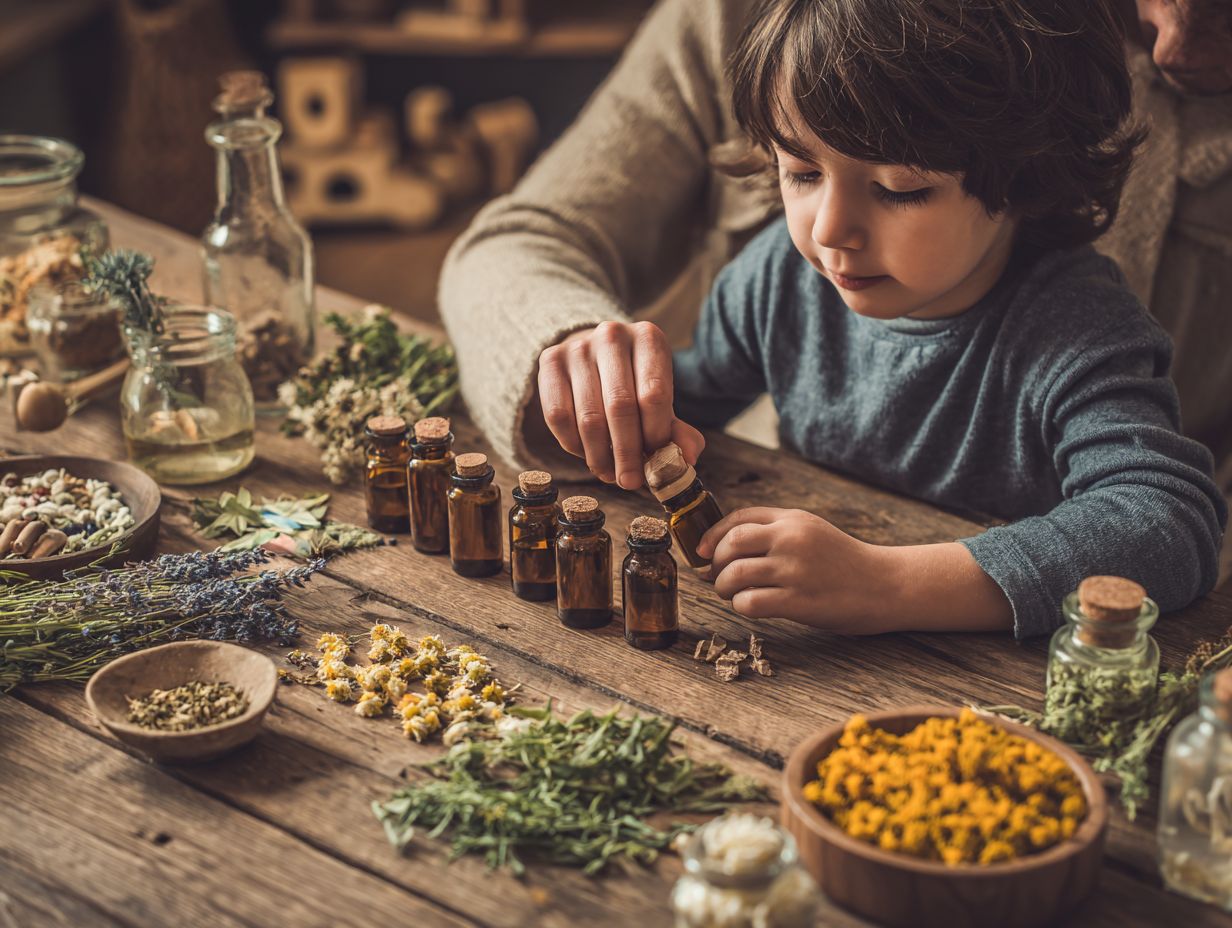
The Children’s Homeopathy Safety Data gives information about how common homeopathy use is among children and how safe people think it is. It also looks at the role of social media and clinical results related to its effectiveness. This data offers a snapshot of homeopathy’s role in children’s healthcare, highlighting usage trends, safety perceptions, and its impact on conventional medicine practices.
Usage Statistics indicate that only 1% of children used homeopathy in the previous year, with a mere 0.2% visiting homeopathic practitioners. This low percentage suggests that homeopathy is not a mainstream choice for children’s healthcare, possibly due to limited acceptance or awareness among parents and caregivers. In contrast, in 2001, a significant 75% of Canadian children used natural health products, which may include homeopathic remedies, showcasing a broader acceptance of alternative health approaches during that time.
Safety and Efficacy Data shows different views on homeopathy. On one hand, 54% of nano-influencers on Instagram promote homeopathy, indicating a substantial social media presence which might influence public opinion and adoption. On the other hand, only 35% of clinical studies report positive results for homeopathy, suggesting skepticism in the scientific community regarding its efficacy. This discrepancy between social media endorsement and clinical validation highlights the ongoing debate about homeopathy’s effectiveness.
Moreover, a 20% reduction in antibiotic use in an allergy study linked to homeopathy points to its potential in reducing reliance on conventional medications, potentially benefiting antibiotic resistance trends. This finding may encourage further research into homeopathy as a complementary approach to traditional treatments, particularly in managing conditions like allergies.
The Children’s Homeopathy Safety Data highlights the difficult aspects of using homeopathy in children’s healthcare. While usage remains low, social media proponents and some clinical findings suggest potential benefits, warranting cautious exploration and further research to validate efficacy and safety in broader applications.
Regulatory Standards and Approvals
Health Canada has established strict rules for approving homeopathic products, ensuring they are safe and effective for children.
Homeopathic remedies in Canada are classified into two main categories: ‘prescription’ and ‘non-prescription’.
Prescription products typically require clinical trials to demonstrate safety and efficacy, undergoing a thorough review process by Health Canada, as detailed in the information provided by Canada.ca.
Non-prescription remedies, while still regulated, may require less stringent evidence. Clinical trials are important for both categories as they confirm claims and back up product labeling.
Manufacturers must provide a detailed report that includes information on ingredients, how the product is made, and any current clinical data to start the approval process.
Quality Control in Homeopathy
Keeping strict quality control in homeopathy is important to reduce risks and make sure products for children work effectively.
To do this, organizations generally use strict testing methods, such as following Good Manufacturing Practices (GMP) to monitor production steps.
Detailed checks on ingredient sourcing guarantee the use of only top-quality raw materials. Clinical effectiveness is often evaluated through randomized controlled trials, which provide reliable data on product safety.
Regular batch testing can identify any contamination issues before the product reaches consumers. Ensuring staff is trained in quality protocols also helps maintain consistency and safety standards across all operations.
Potential Risks of Homeopathic Products
Homeopathic products are widely used, but they may be dangerous. Parents should understand these dangers to make informed decisions about their children’s health. If you’re interested in learning more about the practices and principles behind these remedies, you might appreciate our detailed overview on homeopathy principles and practices.
Adverse Reactions and Side Effects
Sometimes people have negative reactions to homeopathic treatments, but these reactions are usually uncommon and not as serious as side effects from regular medications.
Parents should remain vigilant for symptoms such as skin rashes, digestive issues, or unusual behavior changes in their children.
For example, if a child experiences increased irritability after beginning a remedy, it may be a sign of sensitivity to the treatment. It’s important to monitor these responses. Keeping a journal can help you note any changes linked to the homeopathic dose.
If any side effects occur, talk to a doctor to check if the treatment is right and to keep the child safe.
Interactions with Conventional Medications
Homeopathic products may interact with conventional medications, potentially affecting treatment outcomes, especially in pediatric patients.
To safely handle possible interactions, parents should follow certain steps.
- Consult a healthcare provider before introducing any homeopathic remedies alongside prescription medications.
- Keeping a detailed list of all medications and homeopathic products used helps providers assess risks.
- Monitor your child’s response closely for any unusual side effects.
- It can be beneficial to space doses of homeopathic treatments and conventional medications by at least 30 minutes.
- Always make sure to talk with healthcare professionals for a well-organized plan for your child’s health.
Usage Guidelines for Homeopathic Products in Children
It is important to follow correct instructions when giving homeopathic products to children to make sure they are safe and work well.
Dosage Recommendations
Dosage recommendations for homeopathic products vary widely based on age, weight, and the specific condition being treated.
For example, for children aged 2-6 years, a common remedy like Chamomilla might be administered as 3-5 pellets of 6C, taken two to three times daily for teething discomfort.
Always read product labels for details on ingredients and ask a healthcare professional for guidance to adjust dosages correctly. It is important to monitor how the child reacts after starting treatment. If symptoms continue or get worse, change or stop the treatment and consult a doctor.
Setting the correct dose is important for safety and effectiveness.
Consultation with Healthcare Providers
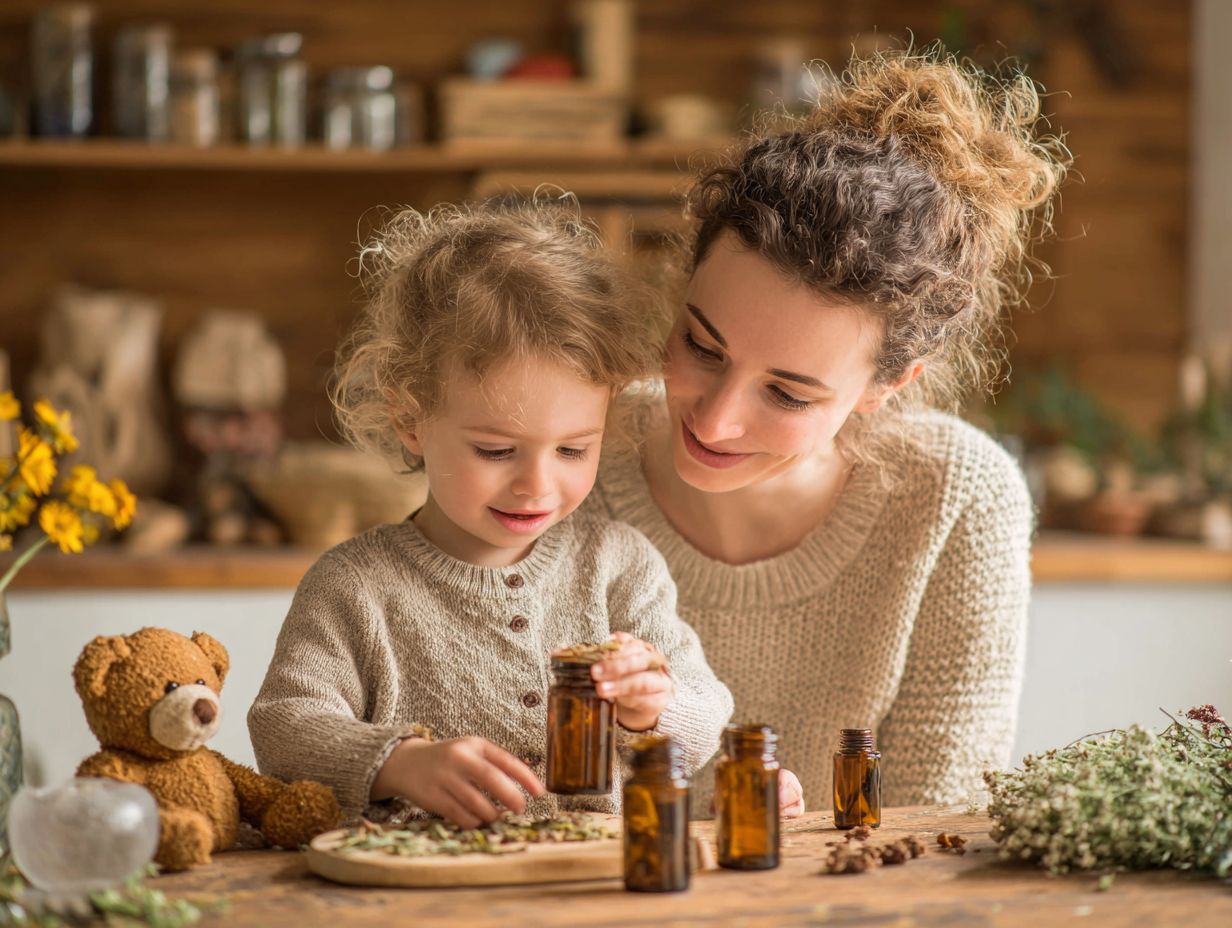
Talking to doctors is important before beginning any homeopathic treatment to make sure it works well with current health care plans.
To facilitate open dialogue, prepare specific questions in advance. For instance, inquire about potential interactions between homeopathic remedies and prescribed medications, as some can diminish effectiveness.
Share the full list of current medications or treatments you’re using to help the provider assess compatibility. If you’re nervous about the conversation, consider bringing a supportive family member or friend for moral support.
Write down any problems or experiences you’ve had with homeopathy to provide helpful background during your talk.
Common Homeopathic Remedies for Children
People often recommend some homeopathic remedies for children to deal with common issues such as colds, stomach issues, and allergies.
Cold and Flu Symptoms
Homeopathic remedies, such as Oscillococcinum and Aconitum, are commonly used to alleviate cold and flu symptoms in children.
Oscillococcinum should be taken when flu symptoms first appear. For children between 2 and 12 years old, give 30 tiny pellets every 6 hours until they improve. Studies indicate it effectively reduces symptom severity and duration when used early.
Aconitum can help with cold symptoms. Use a strength of 30C and give 5 pellets every 2 hours for sudden symptoms. Research indicates that Aconitum helps with sudden chills and fever.
Always check with a doctor before using this to make sure it’s right for your child.
Digestive Issues
Homeopathic treatments like Nux vomica and Chamomilla are often employed to address digestive issues such as colic and upset stomach in children.
Nux vomica is particularly effective for symptoms like bloating and irritability, with a typical dosage being 6C to 30C, administered two to three times daily.
Chamomilla, on the other hand, is beneficial for colicky pain and is often given in a 30C potency, taken as needed.
Watch the child after giving the medication; if symptoms last more than a day or get worse, talk to a doctor.
Always start with lower potencies to gauge tolerance, adjusting as necessary.
Allergies and Skin Conditions
Some natural remedies for allergies and skin problems in children are Sabadilla for hay fever and Graphites for eczema.
Other notable remedies include Pulsatilla, which can be effective for runny noses and excessive mucus, especially in children who thrive in fresh air.
For itchy, inflamed skin, consider using Rhus toxicodendron; administer these remedies in a 30C potency, typically three times daily.
It’s important to monitor for potential side effects, such as temporary worsening of symptoms, which can occasionally occur. Always talk to a certified homeopath or health expert before beginning any treatment, especially for children, to make sure it is safe and the dosage is correct.
Parental Considerations and Responsibilities
Parents play a key role in ensuring that homeopathy is used in a safe and correct way for their kids. They need to make informed choices and pay close attention.
Informed Decision-Making
To make informed choices, it is important to know both the advantages and drawbacks of using homeopathic treatments for children.
To effectively evaluate homeopathy for your child, begin by researching established remedies such as Aconite for colds or Chamomilla for teething discomfort.
Consult resources like the National Center for Homeopathy or reputable medical websites to discern which treatments align with your child’s specific needs.
Talking to experts in homeopathy can offer useful information. It’s essential to weigh anecdotal evidence against scientific studies, focusing on symptoms that show responsiveness to these remedies.
Keep track of developments and talk openly with your child’s doctor to provide complete care.
Monitoring Child’s Response
Regularly monitoring a child’s response to homeopathic treatments is essential for ensuring safety and efficacy, allowing for timely adjustments if necessary.
To effectively track your child’s symptoms and responses, start by keeping a detailed diary. Note the date, homeopathic remedy taken, dosage, and any observed symptoms or behavioral changes.
For instance, you might document a child’s irritability post-remedy, noting the time it occurred and its duration. Check this diary regularly, and schedule meetings with healthcare providers every few weeks to discuss progress and any necessary changes in treatment.
This team effort makes sure changes fit the child’s changing needs.
Summary of Key Points
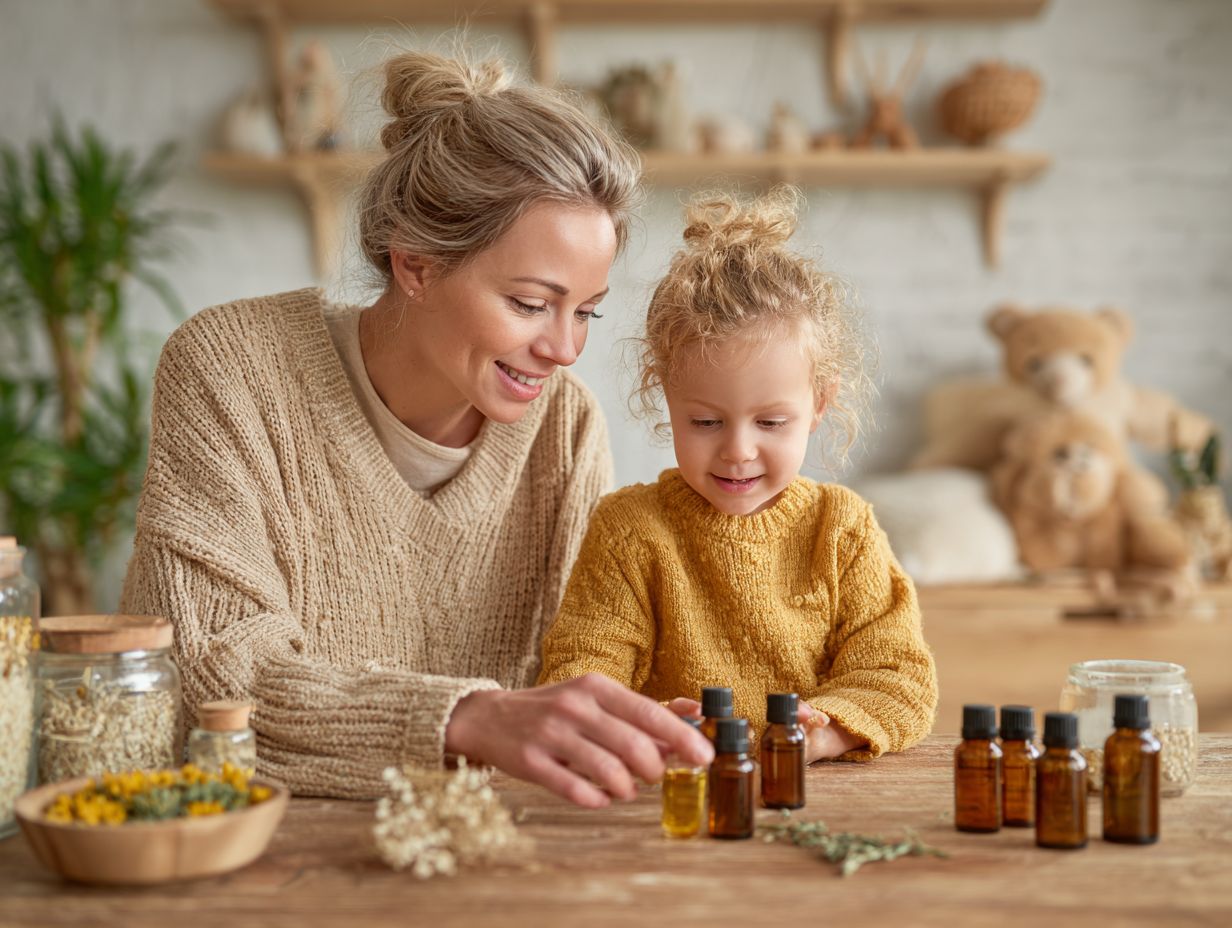
Knowing the basics, safety, and use of homeopathy is important for parents looking for different treatments for their children.
To use homeopathy safely, follow these important steps:
- First, always consult a qualified healthcare professional before starting any treatment.
- Second, research the specific homeopathic remedies and their indications thoroughly; reputable sources include the National Center for Homeopathy.
- Monitor your child’s response closely, and discontinue use if any adverse reactions occur.
By following these guidelines, parents can make informed choices about integrating homeopathy into their child’s health care regimen.
Upcoming Trends in Homeopathy for Kids
In the coming years, research studies and clinical trials will be important in determining how homeopathy can be used for children.
These studies will confirm if homeopathic treatments work and check how well they perform with regular medical treatments.
New digital health tools may come up, enabling online doctor visits and customized healthcare plans.
As rules change, pediatric doctors will have clearer instructions on using homeopathic methods. This setup could help include homeopathy in regular healthcare systems, promoting a more complete approach to children’s health.
In the end, parents may find more choices and help for their children’s health needs, leading to well-informed decisions.
Frequently Asked Questions
What are homeopathic products and are they safe for children?
Homeopathic products are natural remedies made from plants, minerals, and other substances that are diluted and shaken. They are considered safe for children, but it is always best to consult a pediatrician before giving them to your child.
Are there any risks associated with using homeopathic products for children?
While homeopathic products are generally considered safe, there is always a potential risk of allergic reactions or interactions with certain medications. Tell your child’s doctor about any homeopathic treatments they use.
How do I know which homeopathic products are safe for my child?
It is important to only purchase homeopathic products from reputable brands and to check for a “Children’s” or “Pediatric” label on the packaging. This indicates that the product is specifically formulated for use in children.
Can homeopathic products be used to treat specific health conditions in children?
Though some homeopathic items say they can help with certain health issues, remember they should not be used as a substitute for conventional medical care. It is best to consult with a pediatrician before using homeopathic products for a specific health condition in your child.
Is there a recommended dosage for homeopathic products in children?
The recommended dosage for homeopathic products in children can vary based on the age and weight of the child, as well as the specific product being used. It is important to carefully follow the instructions on the packaging or consult with a pediatrician for proper dosing.
Are there any side effects of using homeopathic products in children?
While side effects are rare, some children may experience mild symptoms such as digestive upset or skin irritation from using homeopathic products. It is important to discontinue use and consult with a pediatrician if any adverse reactions occur.

Sheetal Sharda has a background in CS. She got an interest in Holistic living back in 2018, and has since started exploring more into Naturapathy, Holistic Living, Yoga, and more. She got inspired to start SereneClinics to help people find reliable centers across the world.
